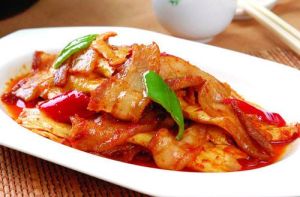Twice cooked pork
|
Twice Cooked Pork
|
Introduction
Twice Cooked Pork or Double-cooked Pork (Simplified Chinese: 回锅肉; Traditional Chinese: 回鍋肉; Pinyin: huí guō ròu).The famous twice cooked pork is a traditional Chinese dish originated from the Sichuan region. It is widely believed that it was first invented by peasants in Song Dynasty (12th century). It is so popular that almost every family in the Sichuan area know how to make the dish. A novice to kitchen can learn this dish quickly, but on the other hand it is a very hard to cook even for professionals, for only few can make it to perfection[1].
In ancient Sichuan area, peasants use boiled pork as a sacrifice in the ancestor worship ceremony. After the ceremony is finished, the peasants would then twice cook the pork as a dish. Bold enough to eat the sacrifice to the dead, Sichuan people have a rather realistic attitude towards formal ceremony.
Sichuan is called Heavenly Land, where is rich in producing pigs, thus providing sufficient supply for making this dish. Twice cooked pork has been such a popular dish to Chinese people's dining table that it can be found throughout the country.
Nutrition
Calories (kcal) 510.68 (Per 100 grams)
Carbohydrate (g) 2.10 (Per 100 grams)
Fat (g) 52.20 (Per 100 grams)
Protein (g) 8.12 (Per 100 grams)
Cellulose (g) 0.24 (Per 100 grams)
Calories
Twice Cooked Pork is estimated to be 510.68 kcal per 100 grams of calories.
In Chinese
Simplified Chinese: 回锅肉
Traditional Chinese: 回鍋肉
Pinyin: huí guō ròu
History
Twice cooked pork(Hui Guo Rou), also known as Ao Guo Rou(熬锅肉), is called Burst Meat(爆肉 Bao Rou) in many places in southern Sichuan. Throughout history literature will find that Burst Meat(Bao Rou) emerged in the last emperor of the Song Sheng Dashou feast, about Emperor Qinzong of Song, 2nd year of the Jingkang reign period. Dongjing meng Hua lu (Chinese name: 《东京梦华录》) or The Eastern Capital: A Dream of Splendor (Chinese name: 《东方之都:辉煌的梦》) written by Meng Yuanlao of the Song Dynasty records: “凡御宴至第三盏(即御宴上皇帝向亲王宗室和文武百官第三次赐酒,一共有九次),方有下酒肉、咸豉、爆肉、双下驼峰角子(形如驼峰的面食)。” Burst Meat(爆肉 Bao Rou) mentioned by Meng Yuanlao is probably known as Twice cooked pork(Hui Guo Rou).[2]
Recipe
Ingredient
| Pork belly (五花肉) | 1 lb |
| Green pepper | 1 stalk |
| Red pepper | 1 stalk |
| Garlic sprouts | 2 stalks |
| Ginger | 5 slices |
| Pixian beanpaste | 1½ large spoon |
| Cooking Wine (or wine) | 1 large spoon |
| Bean sauce | 1 large spoon |
Directions
1. Cook the pork in boiling water till it’s well-done, then put it away and let cool
2. Wait until it is cold and cut the pork into large, thin slices
3. One tea spoon of oil, pork and ginger slices into the pan over medium heat, until the pork turns brown
4. Add 1½ large spoon of Pixian beanpaste
5. Stir fry until chili oil comes out and then add one spoon of bean sauce and cooking wine (replace it with wine if cooking wine is not available). Beware, the beanpaste contains salt so you don’t want too many of that.
6. Put sliced garlic sprouts, green and red peppers.
7. Stir fry till the peppers are just tender
Story
The Sichuan people have a tradition of enjoying a feast every 1st and 15th of lunar months, with twice-cooked pork as the main course.
Similar Food
- ↑ [1]Zhou Dan. The Twice Cooked Pork[J]. Shanghai Seasoning,2007,(07):19.
- ↑ https://ctext.org/wiki.pl?if=gb&res=712358&searchu=%E7%88%86%E8%82%89&remap=gb

